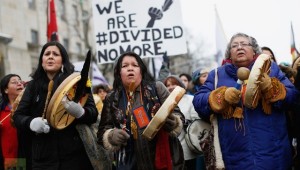Assignment 1:5
When the world was still young it was a beautiful place. There was peace and harmony among all of its inhabitants. No creature wanted for anything because everything was plentiful. Humans lived in harmony with the land and no one took more than they needed.
This way of life continued for thousands of years, and everyone was happy except a small group of people. There was no name for these people at this time but you and I would commonly label them as witches. The group of witches were greedy. They always wanted more: more food than they needed more furs than they could wear. They disrupted the balance and harmony of Earth and upset it’s inhabitants, and as a result the other humans decided to banish them to the mountains in hopes that they would change their ways.
The mountains were harsh and cold. Food was scarce and living was hard. The witches, instead of seeing the error in their ways, became angry for being sent to this desolate place and soon after their arrival began concocting a plot for revenge.
One stormy night in one of the mountain’s dark caves all the witches converged to plot their revenge. They came up with a contest to see who could create the scariest thing to send to the rest of the world. Each and every witch tried to create the scariest thing they could think of. Some created hideous monsters with two heads, or a single eye while others creates poisonous potions or curses to send out onto the unsuspecting world.
Finally there was only one witch left to perform. This witch didn’t preform a spell or create a hideous monster. No she did not. Her idea was much scarier than that. She told a story. It was a story that had never been told before in the history of the Earth. It spoke of unimaginable horrors. It described horrible wars filled with death and destruction. It spoke of plagues and disease that lead to unthinkable pain and suffering of humans and animals alike.
The story brought silence to this rambunctious gathering and everyone knew this witch’s stories had won the contest. She had brought evil into this world to wreak havoc upon its inhabitants forever.
As soon as the words left her mouth “it was too late. For once a story is told, it cannot be called back. Once told, it is loose in the world” (King 10)
For this assignment I wanted to keep as many original aspects of Thomas King’s story as possible. I did this because I think it reflects how oral tradition and the art of storytelling affects stories over time. Stories change and are adapted by each new teller of a tale. They can change every time they are told even if it’s only in small ways. By keeping the ideas of the witches’ contest I was able to elaborate and expand of the original tale. I think the story is quite different even though I kept the original plot and ending. It developed into a completely different tale.
During the process of memorizing my story and retelling it to my friends and family I realized how uncomfortable I was telling a story orally. I have absolutely no experience storytelling besides reading the occasional book out loud. It was very uncomfortable for me especially because I had made most of it up. I was surprised at myself for being nervous about what they would think about my story. I definitely prefer to write a story over speaking it, but this is probably because it is what I am accustomed to doing. I am interested to keep trying to share more stories with people and see if I become more comfortable with the process.
Works Cited:
King, Thomas. The Truth About Stories: A Native Narrative. Peterbough: Anansi Press. 2003. Print.


